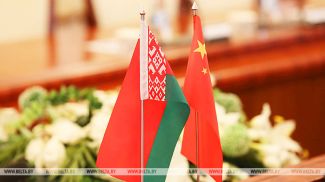The head of state and the government have formulated a number of systemic tasks, including the accelerated development of regions with the population of over 80,000 people. Reducing differences between regions – the level of earnings between small and major industrial population centers – is also a priority. A systemic document has been worked out to achieve that goal – a draft concept of the state policy on regional development of Belarus. It is based on two blocks – an economic block and a social one. Representatives of the Economy Ministry and the National Academy of Sciences of Belarus talked to reporters to highlight priorities of development of the regions.
The economic block
Deputy Economy Minister Tatiana Brantsevich said: “We've identified five groups in order to systematize the regions. Those are the capital city and the surrounding districts, oblast capitals, industrial centers with the population of 80,000 people and more, industrial-agrarian regions, and agrarian-industrial regions. Development incentives have been determined for each group of the regions. The less developed the region is, the more preferences it gets.”
In her words, the draft concept reflects such a novelty as fiscal transfers. A draft presidential decree on the mechanism of fiscal transfers has already been forwarded to the central government. “When an investor makes capital contributions, the state budget will return some of the money depending on results of the project's implementation (three stages have been determined). The investor's outlays will be compensated like that. If the investment project is implemented in a less developed region, the size of the fiscal transfers will be larger than the size of the fiscal transfers in a more developed region,” the deputy economy minister explained.
The social block
Comfortable life of the population in all the regions is the key priority. “The draft concept stipulates important messages in education and healthcare. Interregional centers able to provide more qualified aid are one of the ideas. In other words, every person will get access to quality medical services. As for the transport complex, we focus on one-hour availability and the ability to comfortably reach any place of work,” Tatiana Brantsevich noted.
Investment sites and industrial sites have been picked out in industrial centers with the population of 80,000 people and more. A concept for the industrial belt of Minsk Oblast has been worked out for the sake of development of the regions adjacent to the capital city.
Villages of the future
Villages of the future are another important element of the concept. “We are talking about more comfortable life in the countryside. A government resolution is already available. It singles out the population centers where a set of measures to achieve better living standards will be implemented. It reflects the availability of sport facilities, asphalted locations, libraries – the social standards that allow the population to live in comfort,” the deputy economy minister said.
Representatives of the Economy Ministry met with representatives of the regions and science in the National Academy of Sciences of Belarus on 8 June to discuss the main provisions of the draft concept. Tatiana Brantsevich said: “The concept has already been reviewed by the government. It is now in the presidential administration so that the head of state could evaluate the mechanisms the government suggests. Apart from that, a set of measures has been prepared. It is essentially a list of regulatory acts, which government agencies will have to work out in furtherance of the messages the concept stipulates.”
Contribution of science
Director of the Economy Institute of the National Academy of Sciences of Belarus Vasily Gursky underlined that matters of regional development had always been paid close attention in Belarus. Regular trips of the head of state and program documents adopted for the sake of development of individual regions, including Vitebsk Oblast, Orsha District, are a testimony to that. “The concept of the state policy on regional development is being worked out upon instructions of the president for the sake of systematizing this great work. I should note that cooperation between scientific organizations and government agencies plays a major role in the development of this document and in the development of the main program documents on Belarus' social and economic development. We've discussed the main provisions of the concept today so that the document would be systemic and scientific and able to contribute to the development of regions of our country,” he stressed.
The scientist is convinced that Western sanctions will not impede the realization of this concept. “The effect of the sanctions on our economy is not directly related to some specific regions of the country. The restrictive measures primarily target individual enterprises. There can be some negative impact but on the whole, the economic policy of our state was directed towards import substitution a long time ago and is well-prepared for various troubles in the form of illegitimate sanctions,” Vasily Gursky said.
The draft concept reflects the main trends of regional development at present and provides for ways to stimulate the development of the manufacturing potential in addition to offering tools for raising investments.













